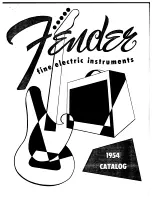
3
When tuning a brand-new string, always bring it up
to pitch slowly. Otherwise, the rapid stretching may
cause the string to break.
Re-Stringing
The procedure for re-stringing acoustic guitars,
electric guitars and basses is quite similar in the way
the strings are wound onto the tuning machines.
There are differences, though, in how the strings are
attached to the bridges of acoustic and electric guitars.
Guild flat-top acoustics have a pin-style bridge with
holes and bridge pins to hold the strings in place. Guild
jazz and electric guitars have a surface-mounted bridge
or slotted tailpiece through which the strings are fed.
To string a flat-top, remove the bridge pin and the
old string, drop the ball end of the new string into the
hole in the bridge, then re-insert the bridge pin to
keep the string in place. Make sure that the bridge pin
is positioned with the groove over the string. Do not
hammer the bridge pin in. A firm push with the
thumb will secure it in place.
To string an electric, simply feed the string through
the appropriate hole in the bridge or slot in the
tailpiece.
To attach a string to the machine head, thread it
through the hole or slot on the machine head, run it
halfway around the post, then underneath the main
length of the string. Next, pull the string end back
over the main length (see illustrations , 2 and 3).
Summary of Contents for Acoustic guitar
Page 1: ...Owner s Manual Warranty...





























